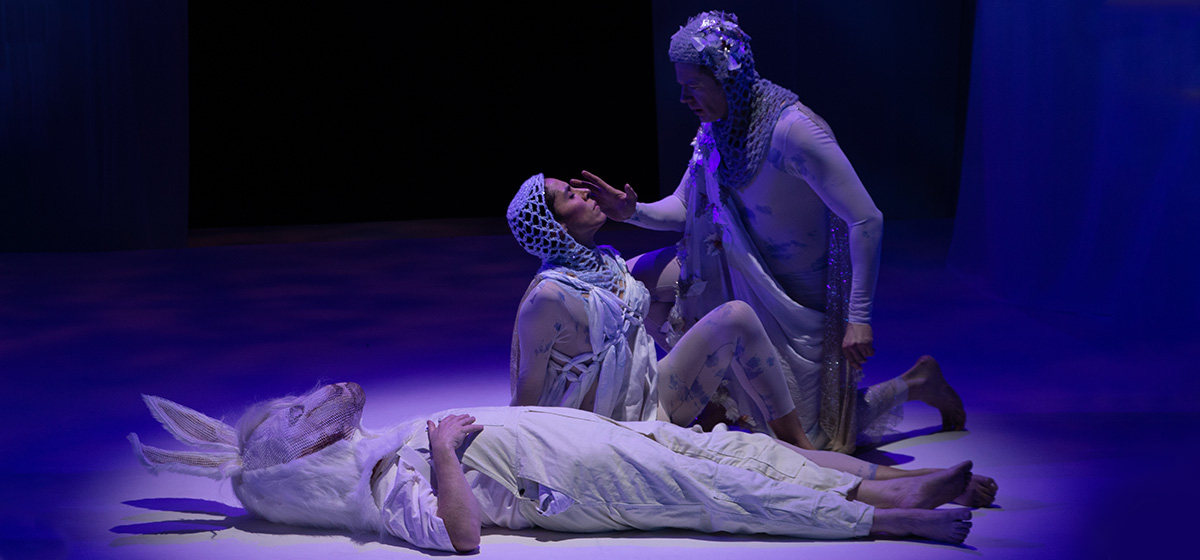PICT’s “A Midsummer Night’s Dream”

There is an effulgence to William Shakespeare’s work that is always better to channel than to distort. And this is especially true of the luminous “A Midsummer Night’s Dream,” his first undeniable masterpiece, composed during the winter of 1595-96, and performed this midwinter in sly context by PICT Classic Theatre. For when better to have a dream of midsummer, than in the heart of its antipodal season?
Something transformational seems to have occurred between this play and the one Shakespeare composed immediately prior, “Romeo and Juliet.” It’s as if, in the space of a few weeks or months, his dramatic and poetic powers blossomed and congealed into the force of nature that his art was to become ever after. Ironically, PICT’s first production in this space—the Fred Rogers Studio at WQED—was “Romeo and Juliet” in 2017, and a similar transformation seems to have occurred with the company. Whereas then the stage was tremulous and had the percussive effect of making footsteps sound like drumbeats, now it has a solid, earthy feel, and the acoustic qualities of the theatre in general are much improved.
It’s as if director Alan Stanford has figured everything out and has brought together the optimal cast, the optimal crew, and now the optimal theatre to engender a kind of production that may have not been possible before, as PICT never quite had the ideal platform to allow its work to sing towards its fullest glory. (For example, as brilliant as its recent “Oedipus Rex” was, it felt like the performance had to fight its way through the dead church air of the deconsecrated Union Project performance hall to reach the audience).
To do Shakespeare well is much harder than to do Shakespeare “new,” which is why most companies opt for the latter. But director Stanford has achieved something remarkable in this production by accomplishing both—creating a luminous vision of a visionary play that is fresh and exciting, yet does not contort the playwright’s original ethos. Central to this achievement is the rare synthesis of set, lighting, and costumes that add so much to this “dream” play, yet are never distracting, as so often is the case in most other productions.
What lighting designer Keith A. Truax and assistant designer Elizabeth Andrews have achieved is utterly sublime and really must be experienced to be understood; it’s as if the air is micro-dosed with hallucinogens—you can’t really see them, but you know they’re there because the colors evolve and writhe, as if you’re seeing the emotions of the characters realized as physical manifestations of light. The effect is startling, like the little bursts of elation you feel from the sun when walking through the woods on a bright day.
The canvas for this is the modernist, minimalist set conceived by Stanford. It comprises a freestanding, rectangular, white stage, with four undulating, translucent curtains in tubular form, reminiscent of the transporter room in the original Star Trek television series. Martha Graham would love to dance through it. How this transmogrifies into the woodland realm of fairies and sensuous meadows for young lovers to frolic through I cannot explain, yet it does, like an enchanting portal of belief.
Stanford understands that this is a play about the intoxication of sight, which correspondingly supports Shakespeare’s premise that love can blind us, as Helena proclaims in the first act:
Love looks not with the eyes but with the mind;
And therefore is wing’d Cupid painted blind.
In fact, the words “eye” and “eyes” occur more in this play than any other work of Shakespeare’s. Yet true to the idea of a dreamscape, we are not told what to see, we must imagine it, as there are no trees, no rocks, no streams, no woods. There are just the players, and the blindness of love. And the simple choice to make every character barefoot allows us to project the sense of grass under their feet. (If you’ve ever wanted to experience being immersed in a world of synesthesia, this is your chance).
Costume designer Zoe Baltimore weaves the actors’ clothing into this phantasmagoric world in astounding ways, from the silky pajama-like garb of the young lovers, to the shimmering skins of the fairies, and the rough overalls of the “mechanicals” (i.e. artisans)—all of which are white/beige/neutral. They allow the projected colors to inundate them like the undulating hues of an octopus adapting to the physical and psychic realms it flows through.
Bottom—the comical and therianthropic character that presages the Bard’s glorious creation Falstaff—is raised to hilarity by Martin Giles in a brilliant casting choice. Giles can bring the house down with a mere three words, such as the self-deprecating comment “This was lofty” in the middle of his own speech. His humor, and all the humor delivered in this production—especially during the play-within-the-play—is as fresh and contemporary as anything you’ll hear on late night TV. It’s such a gift to experience Shakespeare’s comic genius as it must have sounded to audiences four centuries ago.
Shammen McCune (Hipolyta/Titania) and Allan Snyder (Theseus/Oberon) are phenomenal in their individual scenes, and especially when they play off each other. Both are veteran actors who bring resonance to their interpretations, and have a way with Shakespearean language that is a joy to hear. Snyder is also an accomplished singer who heightens the musical portions of the show.
As the love interests, Saige Smith (Hermia/Starveling) and Zoe Abuyuan (Helena/Snout) bring vivacity and charm to their roles and avoid any ingénue tropes that might tempt less accomplished actors.
On the male side of the love equation, David Toole (Demetrius/Snug) and Ryan Patrick Kearney (Lysander/Flute) are strong and creative in their interpretations, and not afraid to flaunt a little beefcake when they tear off their shirts in mock heroic manner.
James FitzGerald (Egues/Quince) becomes the character(s) he portrays to such a degree that it is hard to fathom how he goes through life as himself when he is so convincing as someone not himself. His scenes with Martin Giles are scintillating.
Jacob Epstein offers an inspired Puck, perhaps one of the most difficult Shakespearean roles in which to avoid pastiche. Prior to the Victorian era and the subsequent writings of authors such as Sir James Barrie, fairies were malevolent creatures, and the name Puck had a demonic connotation. Epstein embodies both the mischievous and benevolent forces that battle within this complicated character, and he is both humorous and androgynous without appearing tendentious.
One might say that this is a very erotic show, but only up to a point, as the erotic is always met with mirth and ends in a laugh, which is how the bawdy Elizabethans would have liked it. “A Midsummer Night’s Dream” was written during a very difficult year in England’s history—the public rioting by young apprentices protesting rising prices and horrible living conditions resulted in public executions in London—and the 1590s were a decade of social and political crisis in England. That a comedy of such depth and originality (in fact this is one of only three of Shakespeare’s plays not based on a primary source) arose in these circumstances is perhaps no surprise. Comedy and tragedy are always intertwined, and one can usually be counted on to give birth to other.
So here we have a play set in summer, yet performed in winter, and that is so full of light, yet was created in a time of darkness. And is just as relevant to the 21st century as it was to the 16th. In fact, I’m sure that theatregoers from 1596 would laugh just as hard as the audience did on opening night at PICT in 2020. And I’m also sure that if you miss this production, you’ll be missing one of the great Shakespearean experiences of your life.
“A Midsummer Night’s Dream” continues through February 29, Fred Rogers Studio at WQED, 4802 Fifth Avenue, Oakland, $15-48. 412-561-6000 or www.picttheatre.org.





